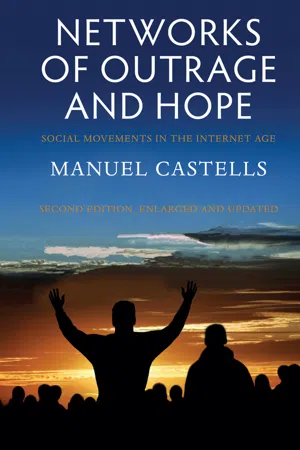
Networks of Outrage and Hope
Social Movements in the Internet Age
Manuel Castells
- English
- ePUB (apto para móviles)
- Disponible en iOS y Android
Networks of Outrage and Hope
Social Movements in the Internet Age
Manuel Castells
Información del libro
Networks of Outrage and Hope is an exploration of the new forms of social movements and protests that are erupting in the world today, from the Arab uprisings to the indignadas movement in Spain, from the Occupy Wall Street movement to the social protests in Turkey, Brazil and elsewhere. While these and similar social movements differ in many important ways, there is one thing they share in common: they are all interwoven inextricably with the creation of autonomous communication networks supported by the Internet and wireless communication. In this new edition of his timely and important book, Manuel Castells examines the social, cultural and political roots of these new social movements, studies their innovative forms of self-organization, assesses the precise role of technology in the dynamics of the movements, suggests the reasons for the support they have found in large segments of society, and probes their capacity to induce political change by influencing people's minds. Two new chapters bring the analysis up-to-date and draw out the implications of these social movements and protests for understanding the new forms of social change and political democracy in the global network society.
Preguntas frecuentes
Información
OCCUPY WALL STREET:
HARVESTING THE SALT OF THE EARTH
THE OUTRAGE, THE THUNDER, THE SPARK
#occupywallstreetAre you ready for a Tahrir moment? On September 17th, flood into lower Manhattan, set up tents, kitchens, peaceful barricades and occupy Wall Street.
A worldwide shift in revolutionary tactics is underway right now that bodes well for the future. [There is a] spirit of this fresh tactic, a fusion of Tahrir with the acampadas of Spain.The beauty of this new formula … is its pragmatic simplicity: we talk to each other in various physical gatherings and virtual people’s assemblies. We zero in on what our one demand will be, a demand that awakens the imagination and, if achieved, would propel us toward the radical democracy of the future … and then we go out and seize a square of singular symbolic significance and put our asses on the line to make it happen. The time has come to deploy this emerging stratagem against the greatest corrupter of our democracy: Wall Street, the financial Gomorrah of America.On September 17, we want to see 20,000 people flood into lower Manhattan, set up tents, kitchens, peaceful barricades and occupy Wall Street for a few months. Once there, we shall incessantly repeat one simple demand in a plurality of voices … Following this model, what is our equally uncomplicated demand? … [It is the one] that gets at the core of why the American political establishment is currently unworthy of being called a democracy: we demand that Barack Obama ordain a Presidential Commission tasked with ending the influence money has over our representatives in Washington. It’s time for DEMOCRACY NOT CORPORATOCRACY, we’re doomed without it.This demand seems to capture the current national mood because cleaning up corruption in Washington is something all Americans, right and left, yearn for and can stand behind … This could be the beginning of a whole new social dynamic in America, a step beyond the Tea Party movement, where, instead of being caught helpless by the current power structure, we the people start getting what we want whether it be the dismantling of half the 1,000 military bases America has around the world to the reinstatement of the Glass-Steagall Act or a three strikes and you’re out law for corporate criminals. Beginning from one simple demand – a presidential commission to separate money from politics – we start setting the agenda for a new America. Post a comment and help each other zero in on what our one demand will be. And then let’s screw up our courage, pack our tents and head to Wall Street with a vengeance September 17. For the wild, Culture Jammers HQ.
Índice
- Cover
- Title Page
- Copyright
- Preface 2015
- Acknowledgments 2012
- Opening: Networking Minds, Creating Meaning, Contesting Power
- Prelude to Revolution: Where it All Started
- The Egyptian Revolution
- Dignity, Violence, Geopolitics: The Arab Uprising and Its Demise
- A Rhizomatic Revolution: Indignadas in Spain
- Occupy Wall Street: Harvesting the Salt of the Earth
- Networked Social Movements: A Global Trend?
- Changing the World in the Network Society
- Networked Social Movements and Political Change
- Beyond Outrage, Hope: The Life and Death of Networked Social Movements
- Appendix to Changing the World in the Network Society
- End User License Agreement